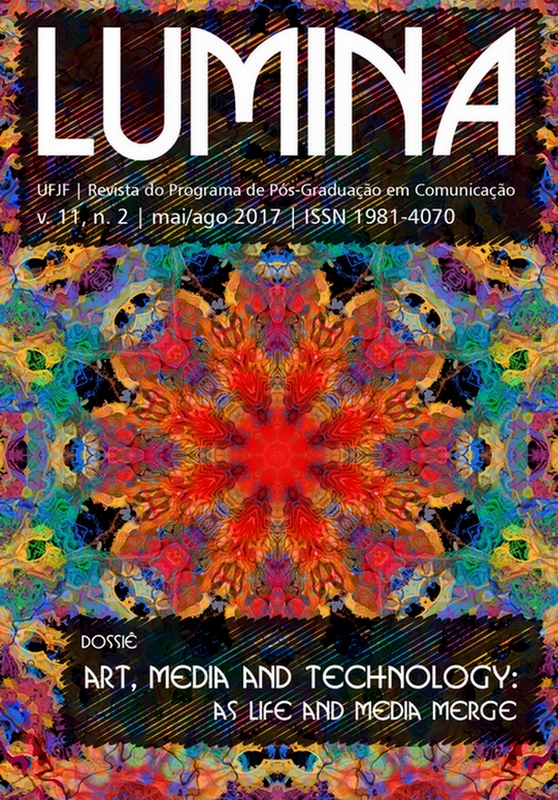Art imitates the Digital
DOI:
https://doi.org/10.34019/1981-4070.2017.v11.21441Palabras clave:
Art, Digital Art, Formal, Abstract systems.Resumen
Where is art in the digital era? This essay identifies the digital as an abstract, formal system. Since art has always relied on formal, abstract systems to carry and deliver itself, what are the implications for art in the digital era? Is the digital a site for art, or is it the other way around? Can there be digital art? Identifying limit and boundary problems as the crucial existential problems for the digital, the essay shows that art has always concerned itself with such problems. This prompts the question as to whether it is possible that human existence and art become the same thing in the digital. Because the digital is currently primarily manipulated in the service of globalist economics, this is clearly not (yet) the case, so what does this mean for art? The essay then briefly examines the self-declared movements of dada, post-digital and post-internet art, concluding that these movements are not capable of questioning the digital as digital, before going on to examine some artists whose practice may be providing guiding lights toward a genuinely digital art.Descargas
Los datos de descargas todavía no están disponibles.
Citas
BISHOP, Claire. Digital Divide. Artforum International, New York 51.1 (Sep 2012): 435-441,534.
CLEMENS, Justin; NASH, Adam. Being and Media: Digital Ontology after the Event of the End of Media.The Fibreculture Journal, issue 24, Jun.2015. Available fromhttp://twentyfour.fibreculturejournal.org/2015/06/03/fcj-173-being-and-media-digital-ontology-after-the-event-of-the-end-of-media/. Accessed on July 25, 2017.
CORBETT, Rachel. Kara Walker Secretly Filmed You Taking Selfies in Front of Her Sphinx. Vulture, 20 November 19, 2014. Available fromhttp://www.vulture.com/2014/11/kara-walker-filmed-you-in-front-of-her-sphinx.html. Accessed on July 25, 2017.
COTTER, Holland. Tuning Out Digital Buzz, for an Intimate Communion With Art.New York Times, March 16, 2015.
CRAMER,Florian. What is Post-digital?A Peer Reviewed Journal About, Aarhus University (Denmark), School of Communication and Culture,volume 3, issue 1, 2014. Available from http://www.aprja.net/what-is-post-digital/. Accessed on July 25, 2017.
FOSTER et al, Art Since 1900: modernism antimodernism postmodernism, London: Thames & 4 Hudson, 2011.
GROYS, Boris.Art Power. Cambridge: MIT Press, 2008.
QIU, Jack Linchuan.Goodbye iSlave. Urbana: University of Illinois Press, 2016.
STACK, John. Tate Digital Strategy 2013–15: Digital as a Dimension of Everything. Tate Papers,no.19, spring 2013. Available from http://www.tate.org.uk/research/publications/tate-papers/19/tate-digital-strategy-2013-15-digital-as-a-dimension-of-everything. Accessed on July 25, 2017.
TURING, Alan. On Computable Numbers, With an Application to the Entscheidungsproblem. In: Collected Works of Alan Turing: Mathematical Logic. Gandy & Yates (eds.). Amsterdam: Elsevier Science B.V., 2001.
TZARA, Tristan. Dada Manifesto, 1918. Available from http://www.391.org/manifestos/1918-dada-5 manifesto-tristan-tzara.html. Accessed on July 25, 2017.
VERWOERT, Jan. Living with Ghosts: From Appropriation to Invocation in Contemporary Art. ART&RESEARCH: A Journal of Ideas, Contexts and Methods. Volume 1. No. 2. Summer 2007. Available from http://www.artandresearch.org.uk/v1n2/pdfs/verwoert.pdf. Accessed on July 25, 2017.
CLEMENS, Justin; NASH, Adam. Being and Media: Digital Ontology after the Event of the End of Media.The Fibreculture Journal, issue 24, Jun.2015. Available fromhttp://twentyfour.fibreculturejournal.org/2015/06/03/fcj-173-being-and-media-digital-ontology-after-the-event-of-the-end-of-media/. Accessed on July 25, 2017.
CORBETT, Rachel. Kara Walker Secretly Filmed You Taking Selfies in Front of Her Sphinx. Vulture, 20 November 19, 2014. Available fromhttp://www.vulture.com/2014/11/kara-walker-filmed-you-in-front-of-her-sphinx.html. Accessed on July 25, 2017.
COTTER, Holland. Tuning Out Digital Buzz, for an Intimate Communion With Art.New York Times, March 16, 2015.
CRAMER,Florian. What is Post-digital?A Peer Reviewed Journal About, Aarhus University (Denmark), School of Communication and Culture,volume 3, issue 1, 2014. Available from http://www.aprja.net/what-is-post-digital/. Accessed on July 25, 2017.
FOSTER et al, Art Since 1900: modernism antimodernism postmodernism, London: Thames & 4 Hudson, 2011.
GROYS, Boris.Art Power. Cambridge: MIT Press, 2008.
QIU, Jack Linchuan.Goodbye iSlave. Urbana: University of Illinois Press, 2016.
STACK, John. Tate Digital Strategy 2013–15: Digital as a Dimension of Everything. Tate Papers,no.19, spring 2013. Available from http://www.tate.org.uk/research/publications/tate-papers/19/tate-digital-strategy-2013-15-digital-as-a-dimension-of-everything. Accessed on July 25, 2017.
TURING, Alan. On Computable Numbers, With an Application to the Entscheidungsproblem. In: Collected Works of Alan Turing: Mathematical Logic. Gandy & Yates (eds.). Amsterdam: Elsevier Science B.V., 2001.
TZARA, Tristan. Dada Manifesto, 1918. Available from http://www.391.org/manifestos/1918-dada-5 manifesto-tristan-tzara.html. Accessed on July 25, 2017.
VERWOERT, Jan. Living with Ghosts: From Appropriation to Invocation in Contemporary Art. ART&RESEARCH: A Journal of Ideas, Contexts and Methods. Volume 1. No. 2. Summer 2007. Available from http://www.artandresearch.org.uk/v1n2/pdfs/verwoert.pdf. Accessed on July 25, 2017.
Descargas
Publicado
2017-08-30
Cómo citar
NASH, A. Art imitates the Digital. Lumina - Revista do Programa de Pós-Graduação em Comunicação da Universidade Federal de Juiz de Fora, [S. l.], v. 11, n. 2, p. 110–125, 2017. DOI: 10.34019/1981-4070.2017.v11.21441. Disponível em: https://periodicos.ufjf.br/index.php/lumina/article/view/21441. Acesso em: 20 dic. 2025.
Número
Sección
Art, Media and Technology: as life and media merge
Licencia
Autores que publicam nesta revista concordam com os seguintes termos:
- Autores mantém os direitos autorais e concedem à revista o direito de primeira publicação, com o trabalho simultaneamente licenciado sob a Licença Creative Commons Attribution que permite o compartilhamento do trabalho com reconhecimento da autoria e publicação inicial nesta revista.
- Autores têm autorização para assumir contratos adicionais separadamente, para distribuição não-exclusiva da versão do trabalho publicada nesta revista (ex.: publicar em repositório institucional ou como capítulo de livro), com reconhecimento de autoria e publicação inicial nesta revista.
- Autores têm permissão e são estimulados a publicar e distribuir seu trabalho online (ex.: em repositórios institucionais ou na sua página pessoal) a qualquer ponto antes ou durante o processo editorial, já que isso pode gerar alterações produtivas, bem como aumentar o impacto e a citação do trabalho publicado (Veja O Efeito do Acesso Livre).








